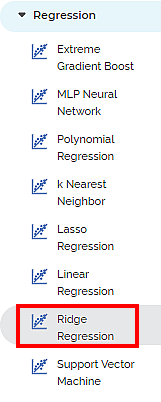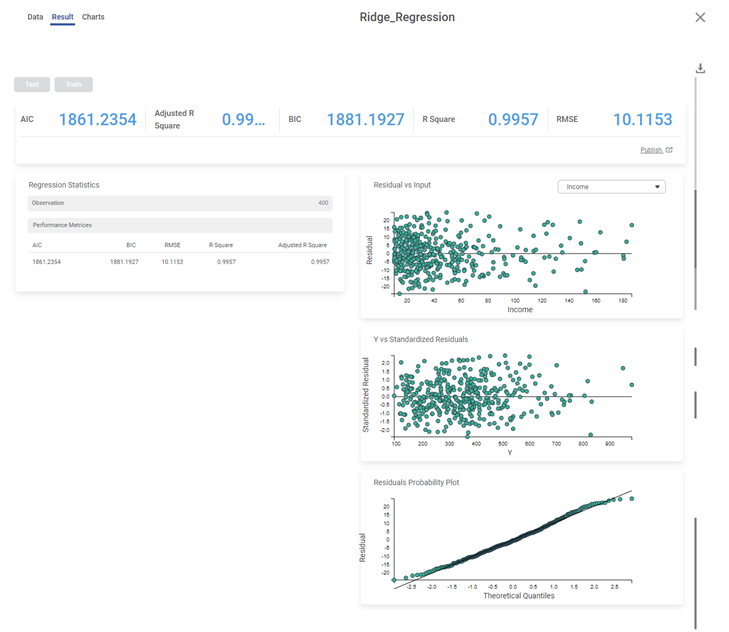Ridge Regression | |||
Description | Predict and analyze data points as output for multiple regression data that suffer from multicollinearity by controlling the magnitude of coefficients to avoid over-fitting. | ||
Why to use | Predictive Modeling | ||
When to use | To regularize the regression, if the Sum of Squared Residuals is too high or too low. | When not to use | On Textual data. |
Prerequisites |
| ||
Input | Any continuous data | Output | The predicted value of the dependent variables. |
Statistical Methods used |
| Limitations | It cannot be used on textual data. |
Ridge Regression is located under Machine Leaning ( ) under Regression, in the left task pane. Use the drag-and-drop method to use the algorithm in the canvas. Click the algorithm to view and select different properties for analysis.
Refer to Properties of Ridge Regression.
Regularization techniques are used to create simpler models from a dataset containing a considerably large number of features. Regularization solves the problem of over-fitting to a great extent and helps in feature selection.
Initially, L1 regularization (Lasso Regression) reduces the number of features by decreasing the coefficients of less important features to zero. After that, the L2 regularization, also called the Ridge Regression, introduces a penalty term to further reduce the magnitude of the remaining features' coefficients. The addition of penalty decreases the difference between the actual and the predicted observations.
Thus, Ridge regression solves the problem of multicollinearity in linear regression. Multicollinearity results when independent variables in a regression model are found to be correlated, and this can have a negative impact on the model fitting and interpretation of results.
Hence, when the magnitude of coefficients is pushed close to zero, the models work better on new datasets and are better optimized for prediction.
Properties of Ridge Regression
The available properties of Ridge Regression are as shown in the figure given below.
The table given below describes the different fields present on the properties of Ridge Regression.
Field | Description | Remark | |
Task Name | It is the name of the task selected on the workbook canvas. | You can click the text field to edit or modify the name of the task as required. | |
Dependent Variable | It allows you to select the dependent variable. |
| |
Independent Variables | It allows you to select independent variables. |
| |
Advanced | Alpha | It allows you to enter a constant that multiplies the L1 term. | The default value is 1.0. |
Fit Intercept | It allows you to select whether you want to calculate the value of constant (c) for your model. |
| |
Maximum Iteration | It allows you to enter the maximum number of iterations. | — | |
Tolerance | It allows you to enter the precision of the solution. | The default value is 0.001. | |
Solver | It allows you to select the method to use to compute the Ridge coefficients. | The available methods are:
| |
Random State | It allows you to enter the seed of the random number generator. | This value is used only when Selection is set to random, and the Solver method selected is Sag or Saga. | |
Dimensionality Reduction | It allows you to select the method for dimensionality reduction. |
| |
| Add result as a variable | It allows you to select whether the result of the algorithm is to be added as a variable. |
| |
| Node Configuration | It allows you to select the instance of the AWS server to provide control on the execution of a task in a workbook or workflow. |
| |
| Hyper Parameter Optimization | It allows you to select parameters for optimization |
| |
Interpretation of Ridge Regression
Ridge Regression performs L2 regularization in order to enhance the accuracy of the prediction. It shrinks the coefficients.
The equation for Ridge Regression is, y = β0 + β1x + (α * (slope)2)
The larger the value of alpha, the model becomes less sensitive to variations of the independent variable.
Example of Ridge Regression
Consider a dataset of Credit Card balances of people of different gender, age, education, and so on. A snippet of input data is shown in the figure given below.
We select Limit, Balance, Income, Cards, and Age as the independent variables and Rating as the dependent variable. The result of Ridge Regression is displayed in the figure below.
The table below describes the various performance metrics on the result page.
Performance Metric | Description | Remark |
RMSE (Root Mean Squared Error) | It is the square root of the averaged squared difference between the actual values and the predicted values. | It is the most commonly used metric to evaluate the accuracy of the model. |
R Square | It is the statistical measure that determines the proportion of variance in the dependent variable that is explained by the independent variables. | Value is always between 0 and 1. |
Adjusted R Square | It is an improvement of R Square. It adjusts for the increasing predictors and only shows improvement if there is a real improvement. | Adjusted R Square is always lower than R Square. |
AIC (Akaike Information Criterion) | AIC is an estimator of errors in predicted values and signifies the quality of the model for a given dataset. | A model with the least AIC is preferred. |
BIC (Bayesian Information Criterion) | BIC is a criterion for model selection amongst a finite set of models. | A model with the least BIC is preferred. |
Table of Contents



